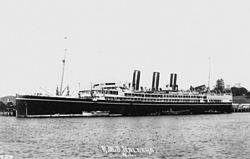Naldera (ship)
|
||||||||||||||||||||||
|
||||||||||||||||||||||
|
||||||||||||||||||||||
|
||||||||||||||||||||||
|
||||||||||||||||||||||
The Naldera was a 1920 posed in service passenger ship of the British shipping company Peninsular and Oriental Steam Navigation Company (P & O), the passenger and mail services from the UK to Australia and later to the Far East was used. It was decommissioned in 1938 and scrapped in Scotland that same year .
history
The steamship Naldera was commissioned by P&O on November 3, 1913 and laid down at the Caird & Company shipyard in Greenock, Scotland , but work on the ship was delayed considerably after the outbreak of the First World War . The ship, 176.81 meters long and 20.51 meters wide, was not launched until December 29, 1917. The Naldera was the 83rd ship built for the P&O shipping company at Caird & Company. At the same time, she was the largest and also the last P&O ship to be built there before the shipyard was taken over by Harland & Wolff. The Naldera (15,825 GRT) had a sister ship , the Narkunda (16,227 GRT), which was built by Harland & Wolff in Belfast , Northern Ireland . The Narkunda was launched a few months later.
The Naldera , built as a passenger and mail ship, had three chimneys, two masts and two propellers and was powered by four-cylinder quadruple expansion steam engines that developed 18,000 PSi and could accelerate the ship up to 17.5 knots. The passenger accommodations were designed for 426 passengers in first class and 247 passengers in second class. The Naldera and the Narkunda were P & O's first three-chimney, the first with a rounded cruiser stern and the largest ships of the shipping company to date. The Naldera was completed in May 1918 as a troop transport , but was no longer used as such. The British government could not commit to any purpose. It was planned successively to use the ship as an armed auxiliary cruiser (Armed Merchant Cruiser), cargo ship , hospital ship and even as an aircraft carrier . But none of these plans were carried out.
On March 24, 1920, the Naldera went through its test drives and was handed over to P&O on the same day. On April 10, 1920, she left for her maiden voyage to Sydney . It was used in passenger and mail traffic from England across the Mediterranean to Australia until it was put on the London - Bombay - Far East route together with the Narkunda in 1931 . When the Narkunda switched from conventional coal to more modern oil combustion in 1927 , this was initially also planned for the Naldera . However, it was not implemented, making the Naldera the last coal- burning ship in the P&O fleet.
Several accidents occurred during the service period. On July 29, 1921, the Naldera collided in the port of Bombay with the anchored Clan Lamont (3,594 GRT) of the Clan Line . The bow then had to be repaired. On October 2, 1924, she collided with the steamer Scotstoun while docking at Tilbury . When water penetrated hold no. 2 in stormy weather on a crossing from Fremantle to Colombo in July 1930, hundreds of tons of frozen meat had to be thrown overboard. In October 1934 the ship was stranded in the Suez Canal for 24 hours . On January 16, 1937, the starboard propeller was damaged during the docking maneuver in Southampton . Replacing the defective propeller took 36 hours.
After two trips to Japan at the end of 1938, the ship was removed from the P&O register. On September 23, 1938, the Naldera ran at the end of its last regular voyage coming from Kobe in Tilbury. Shortly thereafter, the ship was chartered by the British government to transport 2,000 volunteer members of the British Legion Volunteer Police Force across the North Sea . This organization was founded to monitor the legality of the referendum to integrate the Sudetenland into the German Reich . This action, initially approved by Hitler , was rejected by him shortly afterwards. The trip did not materialize.
On November 9, 1938, the Naldera was sold to the P. & W. McLellan Ltd. demolition yard for £ 35,500 . sold in Bo'ness, Scotland, where it arrived that month and was scrapped shortly afterwards.

